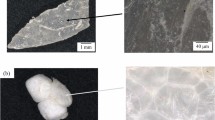Abstract
The plasticizing effect of 4 model volatile compounds (n-hexane, toluene, p-xylene, and ethylbenzene), able to be sorbed on polystyrene (PS) was studied. A large weight fraction range was investigated (up to 0.35) using differential scanning calorimetry. Mathematical modeling, using Fox, Kelly-Bueche, Chow and Gordon-Taylor models, was performed to model the behavior of the glass transition temperature of PS after VOC sorption. A strong plasticization of PS was evidenced by a significant reduction in the glass transition temperature of the binary mixtures (T gm). Among the four studied molecules, the linear one, n-hexane, displayed a better plasticizing efficiency than the aromatic ones, which lay in the same range. Indeed, a 15 % (w w−1) n-hexane content in PS decreased the T gm by 84 K. The Gordon-Taylor model was the best model to fit the experimental data for all the volatile organic compounds tested.
Graphical abstract




Similar content being viewed by others
References
Dimarzio E, Gibbs J (1963) Molecular interpretation of glass temperature depression by plasticizers. J Polym Sci Part A Polym Chem 1:1417–1428
Samus MA, Rossi G (1996) Methanol absorption in ethylene-vinyl alcohol copolymers: relation between solvent diffusion and changes in glass transition temperature in glassy polymeric materials. Macromolecules 29:2275–2288
Blasi P, D’Souza SS, Selmin F, DeLuca PP (2005) Plasticizing effect of water on poly(lactide-co-glycolide). J Controlled Release 108:1–9
Ribeiro M, Pison L, Grolier J-P (2001) Modification of polystyrene glass transition by high pressure methane. Polymer 42:1653–1661
Gmelin E (1997) Classical temperature-modulated calorimetry: a review. Thermochim Acta 304(305):1–26
Menard KP (2008) In: Menard KP (ed) Dynamic mechanical analysis: a practical introduction, 2nd edn. Taylor and Francis, Boca Raton
Fox TG (1956) Influence of diluent and of copolymer composition on the glass temperature of a polymer system. Bull Am Phys Soc 1:1–123
Kelly FN, Bueche F (1961) Viscosity and glass temperature relations for polymer-diluent systems. J Polym Sci L: 549–556
Chow TS (1980) Molecular inerpretation of the glass transition temperature of polymer-diluent systems. Macromolecules 13:362–364
Gordon M, Taylor JS (1952) Ideal copolymers and the second-order transitions of synthetic rubbers. I. Non-crystalline copolymers. J Appl Chem 2:493–500
Kwei TK (1984) The effect of hydrogen bonding on the glass transition temperatures of polymer mixtures. J Polym Sci Polym Lett Ed 22:307–3213
Couchman PR, Karasz FE (1978) A classical thermodynamic discussion of the effect of composition on glass-transition temperatures. Macromolecules 11:117–119
Couchman PR (1978) Compositional variation of glass-transition temperatures. 2. application of the thermodynamic theory to compatible polymer blends. Macromolecules 11:1156–1161
Salazar R, Domenek S, Courgneau C, Ducruet V (2012) Plasticization of poly(lactide) by sorption of volatile organic compounds at low concentration. Polym Degrad Stab 97:1871–1880
Masa A, Biros J, Pouchly J (1973) On the structures and properties of vinyl polymers and their models. XV. Glass transition temperatures in the system polystyrene-diluent. Collect Czech Chem Commun 38:201–204
Riddik JA, Bunger WB, Sakano TK (1986) Techniques of chemistry. Wiley-Interscience, New York
Coker AK (2010) In: Coker AK (ed) Distillation, packed towers, petroleum fractionation, gas processing and dehydration, 4th edn. Gulf Professional Publishing, Burlington
Claudy P, Letoffe JM, Camberlain Y, Pascault JP (1983) Glass transition of polystyrene versus molecular weight. Polym Bull 9:208–215
Kruger K-M, Sadowski G (2005) Fickian and non-fickian sorption kinetics of toluene in glassy polystyrene. Macromolecules 38:8408–8417
Marcilla A, Beltran M (2012) In: Wypych G (ed) Handbook of plasticizers, 2nd edn. ChemTec Publishing, Toronto
Pouchly J, Biros J, Masa A (1973) On the structure and properties of vinyl polymers and their models. XIV. Glass transition temperatures in the system poly(vinul chloride)-diluent. Collect Czech Chem Commun 38:401–407
Boyer S, Grolier J-P (2005) Modification of the glass transitions of polymers by high-pressure gas solubility. Pure Appl Chem 77:593–603
Gendron R, Daigneault LE (1999) Rheological behavior of mixtures of polystyrene with HCFC 142b and HFC 134a. J Cell Plast 35:221–246
Boyer R (1954) Relationship of first to second order transition temperatures for crystalline high polymers. J Appl Phys 25:825–829
Chapoy LL (1974) Properties and structure of concentrated polystyrene solutions. Rheol Acta 13:779–788
Scandola M, Ceccorulli G, Pizzoli M, Pezzin G (1982) Further evidence of an unusual Tg-concentration dependence for plasticized polyvinylchloride. Polym Bull 6:653–660
Pizzoli M, Scandola M, Ceccorulli G, Pezzin G (1983) Comparative study of diluent effects on the glass transition of polyvinylchloride and phenolphthalein. Polym Bull 9:429–436
Ceccorulli G, Pizzoli M, Scandola M (1987) Composition dependence of the glass transition temperature of polymer diluent systems: 1. Experimental evidence of a dual behaviour in plasticized PVC. Polymer 28:2077–2080
Scandola M, Ceccorulli G, Pizzoli M (1987) Composition dependence of the glass transition of polymer diluent mixtures: 2. Two concomitant glass transition processes as a general feature of plasticized polymers. Polymer 28:2981–2984
Riande E, Markowitz H, Plazek D, Raghupathi N (1975) Viscoelastic behavior of polystyrene-tricresyl phosphate solutions. J Polym Sci Part C Polym Symp 50:405–430
Aubin M, Prud’homme RE (1980) Miscibility in blends of poly(vinyl chloride) and polylactones. Macromolecules 13:365–369
Acknowledgments
The authors wish to thank the French National Agency for Research (Agence Nationale de la Recherche) for the research project SafeFoodPack Design (ANR-10-ALIA-009) and all the partners involved in this project.
Author information
Authors and Affiliations
Corresponding author
Rights and permissions
About this article
Cite this article
Kadam, A.A., Karbowiak, T., Voilley, A. et al. Plasticization of amorphous polystyrene by volatile organic compounds. Polym. Bull. 73, 1841–1853 (2016). https://doi.org/10.1007/s00289-015-1580-4
Received:
Revised:
Accepted:
Published:
Issue Date:
DOI: https://doi.org/10.1007/s00289-015-1580-4




